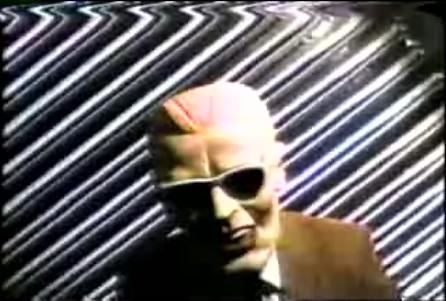Location WGN-TV
WTTW Outcome Unsolved | Participants Unidentified | |
 | ||
Date November 22, 1987 (1987-11-22) | ||
The Max Headroom broadcast signal intrusion was a television signal hijacking that occurred in Chicago, Illinois, United States on the evening of November 22, 1987. It is an example of what is known in the television business as broadcast signal intrusion. The intruder was successful in interrupting two broadcast television stations within the course of three hours. After a brief and only partially successful attempt to break into the signal of intended target of WGN-TV, the signal pirates, whose identities were never found, succeeded in getting their broadcast intruded onto WTTW during an episode of the Doctor Who serial "Horror of Fang Rock." The pirate broadcast, which lasted 90 seconds and was pre-recorded on videotape, featured an individual disguised as television character Max Headroom parodying WGN and television in general. The incident made national headlines and the people responsible have never been identified.
Contents
WGN-TV
The first occurrence of the signal intrusion took place during then-independent station WGN-TV (channel 9)'s live telecast of its primetime newscast, The Nine O'Clock News (now known as WGN News at Nine). During highlights from the Chicago Bears' 30–10 home victory over the Detroit Lions that afternoon in the sports report, the screen went black for 15 seconds, then returned with a person wearing a Max Headroom mask and sunglasses, moving around and bobbing. His head was in front of a sheet of moving corrugated metal, which imitated the background effect used in the Max Headroom TV and movie appearances. There was no audio other than a buzzing noise and an oscillating sound. The hijack was stopped after engineers at WGN switched the frequency of their studio link to the John Hancock Center transmitter.
The incident left sports anchor Dan Roan bemused, saying, "Well, if you're wondering what's happened, so am I." He then unsuccessfully tried to repeat what he was saying before the incident occurred.
WTTW
Later that night, around 11:15 p.m. Central Time, during a broadcast of the Doctor Who serial "Horror of Fang Rock", PBS member station WTTW's signal was hijacked by the same person, apparently, who had broadcast the WGN-TV hijack, this time with distorted and crackling audio.
The show was interrupted by television static, after which the unidentified man wearing the Max Headroom mask and sunglasses appeared, mentioning WGN pundit Chuck Swirsky, who he said he was "better than", going on to call Swirsky a "fricking Liberal". The man started to moan, scream and laugh. He continued to laugh and utter various random phrases, including New Coke's advertising slogan "Catch the Wave" while holding a Pepsi can (Max Headroom was a Coca-Cola spokesperson at the time), then crushed the can, tossed it out of sight, leaned towards the camera and presented the finger wearing a rubber extension over his middle finger, though the gesture was partially off-screen. The man then retrieved the Pepsi can, and sang "Your love is fading", removed the rubber extension, and then began humming the theme song to Clutch Cargo, pausing to say "I still see the X" (often misheard as "I stole CBS"), which referred to the final episode of the series, before resuming humming again. He then began to moan painfully, exclaiming about his piles, after which a flatulence sound was heard. He then stated that he had "made a giant masterpiece for all the greatest world newspaper nerds" (the WGN call letters used by the Chicago television station as well as its sister radio station are an acronym for "World's Greatest Newspaper", in reference to the flagship newspaper of their corporate parent, the Tribune Company's Chicago Tribune). He then held up a glove (similar to the one worn by Michael Jackson at the time) and said, "My brother is wearing the other one." After putting the glove on, he continued, "But it's dirty! It's like you got bloodstains on it!" He then removed the glove and threw it down.
The picture suddenly cut over to a shot of the man's lower torso. His buttocks were partly exposed, and he was holding the now-removed mask up to the camera with the rubber extension now placed in the mouth of the mask, howling, "They're coming to get me!" An unidentified female accomplice wearing a French maid outfit said to him, "Bend over, bitch!" The accomplice then started to spank the man with a flyswatter as the man screamed loudly. The transmission then blacked out for a few seconds before resuming the Doctor Who episode in progress; the hijack lasted for about 90 seconds.
WTTW, which maintained its transmitter atop the Sears Tower, found that its engineers were unable to stop the hijacker due to the fact that there were no engineers on duty at the Sears Tower at the time of the hijacking. According to station spokesman Anders Yocom, technicians monitoring the transmission from WTTW headquarters "attempted to take corrective measures, but couldn't." "By the time our people began looking into what was going on, it was over," he told the Chicago Tribune. WTTW was able to find copies of the hijacker's telecast with the help of Doctor Who fans who had been taping the show.
Reaction
WTTW and WGN-TV joined HBO (which had a similar incident occur 19 months earlier) as instances of broadcast signal intrusion. The Max Headroom incident made national headlines and was reported on the CBS Evening News the next day. WTTW received numerous phone calls from viewers who wondered what had occurred for the duration of the intrusion.
An investigating FCC engineer quoted at the time said the perpetrators of the intrusion faced a maximum $10,000 fine, up to a year in prison, or both.
Not long after the incident, WMAQ-TV humorously inserted clips of the hijacking into a newscast during Mark Giangreco's sports highlights. "A lot of people thought it was real – the pirate cutting into our broadcast. We got all kinds of calls about it," said Giangreco.
